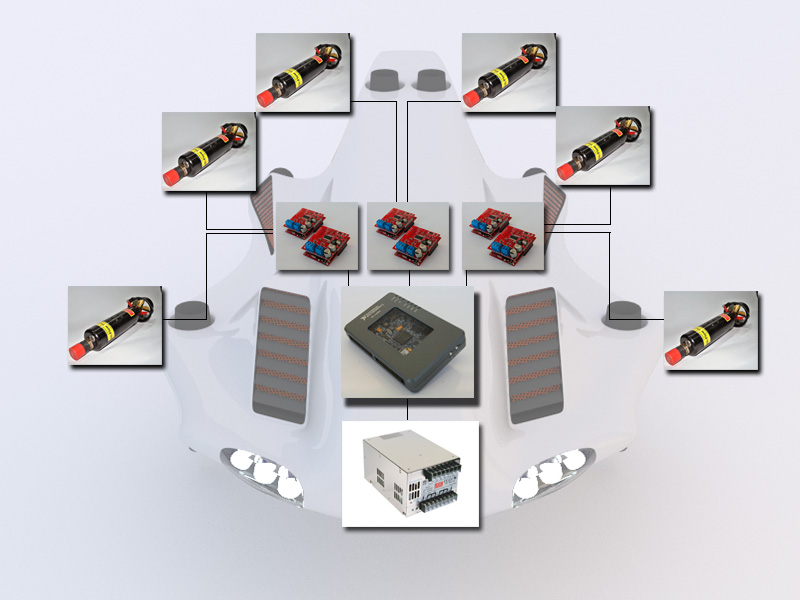- Document History
- Subscribe to RSS Feed
- Mark as New
- Mark as Read
- Bookmark
- Subscribe
- Printer Friendly Page
- Report to a Moderator
- Subscribe to RSS Feed
- Mark as New
- Mark as Read
- Bookmark
- Subscribe
- Printer Friendly Page
- Report to a Moderator
CALYPSO Project - student submarine build
Contact Information
University:
Gimnazija Vič (Vic grammar school)
Team Members (with year of graduation):
Vid Klopčič
Miha Majtič
Urša Primožič
Jernej Nose
Miha Černa
Filip Peter Lebar
Katja Brezovar
Lana Avsenik Žibrat
Faculty Advisers:
Rok Capuder
Timotej Maroševič
- dr. Vida Kariž Merhar
Uroš Puc
Email Address:
Submission Language:
English
Project Information
Title:
CALYPSO project
Description:
The Calypso project developed a functional underwater craft capable of reaching depths of 1000 meters. Its purpose is to explore the Adriatic sea, it can be mounted with a wide array of sensors and several underwater cameras.
Products:
LabVIEW myRIO 2014, NI myRIO
The Challenge:
We know less about our seas and oceans than we know about the surface of Mars. The challenge was to design and build a functional underwater craft that would be capable of exploring more than 90% of the Adriatic Sea. Calypso project is an ongoing (in its 3rd year) project of the students of Vic Grammar school (age 15-18).
The Solution:
THE BUILD
Calypso consists of two mayor parts: the outer and the inner shell. The hard inner shell protects vital parts of the submarine from water and high pressure. It consists of an aluminum tube closed on both sides and houses all of Calypso’s electronic equipment. It is connected directly to the surface through the power supply and data cord. We supply the submarine with 220 AC current which is then converted to 24 V DC.
The outer shell, has a hydrodynamic shape, and is made out of fiberglass. The size of the submarine is 170 cm x 80 cm x 30 cm.The shape itself was inspired manta ray. While in water, it will be flooded from both sides, so there is no need for any extra structural stability. The shell is infused with syntactic foam to ensure neutral buoyancy when the thrusters are not powered on.
It is propelled by 6 underwater thrusters with a pressure rating of 100 Bars of pressure). The positioning of the thrusters enables Calypso to perform underwater maneuvers, and ensures a full 3D mobility.
We managed to write the code for our drivers, and now we can drive the motors at low speeds which is otherwise not possible with the common drivers. Controlling the motors at low speeds gives us better control and handling. Through the supply cable we will 220V AC, which is then transformed to 24V DC.

ELECTRONICS
Calypso is controlled with two independent systems, to ensure redundancy. We use myRIO to control the vital parts of the craft, such as thruster handling, light control and positioning. We found out that LabViews programming environment is very suitable for our students – they can use very advanced functions (such as PID control), even though they don’t yet fully grasp the mathematics involved. Besides the simplicity of use, we find it is very important that the students come into contact with "industrial grade" technology, they will likley use in their future workplaces.
LEVEL OF COMPLETEION
Calypso’s maiden dive was performed in May 2015 near the coast of Portorož in Slovenia, before that we performed several tests in fresh water pools in Ljubljana. The craft can submerse, level itself automatically and sustain its position in several angles.
PROJECT MANAGENENT
Over 35 students (age 15-18) are involved in the project, and during the build there were divided into workgroups, where each of the groups had to design and build one part of the craft. The students also managed the finances and the marketing of the project.
NEXT STEPS
We plan two independent missions this year – to Bled and Bohinj lake in the Slovenian alps. We want to explore the underwater life in both lakes, take samples and if possible map the lake bed. For the last part we still need to develop the imaging system.
Nominate Your Professor
Rok Capuder is a physics teacher at Vič grammar school in Ljubljana. His main interest in the last 5 years are technology based project, that aim to produce a functional prototype. Since 2015, since myRIO was introduced to us, we have been using it constantly.
ATTACHED FILE DESCRIPTION
DSC3861.jpg - outer shell, intakes and lights not installed
DSC3888.jpg - inside of the inner shell, camera installed, not all connection to myRIO are installes
DSC4337.jpg - Images from the test dive in the Adriatic sea
DSC4347.jpg - Images from the test dive in the Adriatic sea
MG_9909.JPG - Images from the test dive of the inner shell - PID testing
Sequence 01_1.f4v - Movie from PID testing at the local pool (use VLC to view)
(movies from the dive in the Adriatic sea will be uploaded soon)
